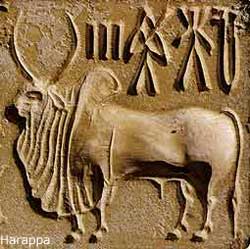 The Indus Valley civilization (also known as Harappan culture) appeared around 2500 BCE along the Indus River valley in Punjab and Sindh. The civilization, with a writing system, urban centers, and diversified social and economic system, was rediscovered in the 1920s after excavations at Mohenjo-daro (which means "mound of the dead") in Sindh near Sukkur, and Harappa, in Punjab south of Lahore. A number of other sites stretching from the Himalayan foothills in Punjab, India in the north, to Gujarat in the south and east, and to Balochistan in the west have also been discovered and studied. Although the archaelogical site at Harrappa was partially damaged in 1857 when engineers constructing the Lahore-Multan railroad used brick from the Harrappa ruins for track ballast, an abundance of artifacts have nevertheless been found. Vishnu >
The Indus Valley civilization (also known as Harappan culture) appeared around 2500 BCE along the Indus River valley in Punjab and Sindh. The civilization, with a writing system, urban centers, and diversified social and economic system, was rediscovered in the 1920s after excavations at Mohenjo-daro (which means "mound of the dead") in Sindh near Sukkur, and Harappa, in Punjab south of Lahore. A number of other sites stretching from the Himalayan foothills in Punjab, India in the north, to Gujarat in the south and east, and to Balochistan in the west have also been discovered and studied. Although the archaelogical site at Harrappa was partially damaged in 1857 when engineers constructing the Lahore-Multan railroad used brick from the Harrappa ruins for track ballast, an abundance of artifacts have nevertheless been found. Vishnu >
Indus Valley civilization was mainly an urban culture sustained by surplus agricultural production and commerce, the latter including trade with Sumer in southern Mesopotamia. Both Mohenjo-daro and Harappa were built according to similar plans of well-laid-out streets, "differentiated living quarters, flat-roofed brick houses, and fortified administrative or religious centers"[4] Weights and measures were standardized throughout the area and distinctive seals were used for identification of property and shipment of goods. Although Copper and bronze were in use, iron was unknown. "Cotton was woven and dyed for clothing; wheat, rice, and a variety of vegetables and fruits were cultivated; and a number of animals, including the humped bull, were domesticated." Wheel-made pottery—some of it adorned with animal and geometric motifs—has been found in profusion at all the major Indus sites. A centralized administration has been inferred from the revealed cultural uniformity; however, it remains uncertain whether authority lay with a priestly- or a commercial oligarchy.
 By far the most exquisite but most obscure artifacts unearthed to date are the small, square steatite seals engraved with human or animal motifs. Large numbers of the seals have been found at Mohenjo-daro, many bearing pictographic inscriptions generally thought to be a kind of script. Despite the efforts of philologists from all parts of the world, however, and despite the use of computers, the script remains undeciphered, and it is unknown if it is proto-Dravidian or proto-Sanskrit. Nevertheless, extensive research on the Indus Valley sites, which has led to speculations on both the archaeological and the linguistic contributions of the pre--Aryan population to Hinduism's subsequent development, has offered new insights into the cultural heritage of the Dravidian population still dominant in southern India. Artifacts with motifs relating to asceticism and fertility rites suggest that these concepts entered Hinduism from the earlier civilization. Although historians agree that the civilization ceased abruptly, at least in Mohenjo-daro and Harappa there is disagreement on the possible causes for its end. Invaders from central and western Asia are considered by some historians to have been "destroyers" of Indus Valley civilization, but this view is open to reinterpretation. More plausible explanations are recurrent floods caused by tectonic earth movement, soil salinity, and desertification.
By far the most exquisite but most obscure artifacts unearthed to date are the small, square steatite seals engraved with human or animal motifs. Large numbers of the seals have been found at Mohenjo-daro, many bearing pictographic inscriptions generally thought to be a kind of script. Despite the efforts of philologists from all parts of the world, however, and despite the use of computers, the script remains undeciphered, and it is unknown if it is proto-Dravidian or proto-Sanskrit. Nevertheless, extensive research on the Indus Valley sites, which has led to speculations on both the archaeological and the linguistic contributions of the pre--Aryan population to Hinduism's subsequent development, has offered new insights into the cultural heritage of the Dravidian population still dominant in southern India. Artifacts with motifs relating to asceticism and fertility rites suggest that these concepts entered Hinduism from the earlier civilization. Although historians agree that the civilization ceased abruptly, at least in Mohenjo-daro and Harappa there is disagreement on the possible causes for its end. Invaders from central and western Asia are considered by some historians to have been "destroyers" of Indus Valley civilization, but this view is open to reinterpretation. More plausible explanations are recurrent floods caused by tectonic earth movement, soil salinity, and desertification.
No comments:
Post a Comment